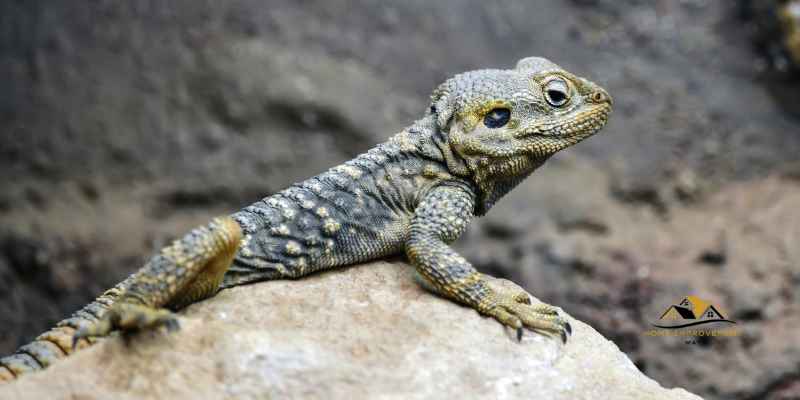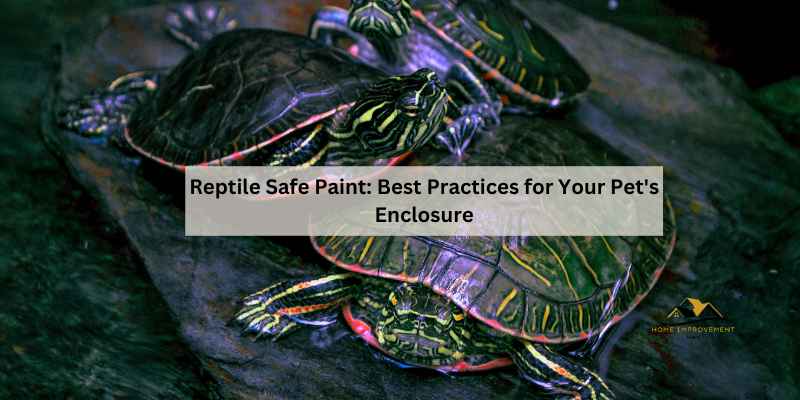Reptile safe paint is essential for creating a safe and healthy environment for your scaly friends. ECOS Paints offers high-gloss, pet-friendly paints in various colors suitable for reptile enclosures.
When using paint for your reptile enclosure, safety should be a top priority, so opt for paints with low VOCs and high durability. It’s crucial to avoid toxic paints and finishes, as fumes can be harmful to reptiles. Stick to non-toxic acrylic paints and ensure that any varnish or sealant used is labeled as non-toxic or low VOC.
By prioritizing safety in your choice of paint and finishes, you can create a comfortable and secure space for your reptiles to thrive.
Understanding Reptile Safe Paint
When it comes to creating a safe and suitable environment for your reptile, using reptile safe paint is essential. Understanding the importance of using reptile safe paint and being aware of the potential risks associated with unsafe paints is crucial for the well-being of your scaly friends. Let’s delve into the significance of using reptile safe paint and the potential risks of using unsafe alternatives.
Importance Of Using Reptile Safe Paint
It’s crucial to prioritize the use of reptile safe paint when designing and customizing your reptile enclosure. Using paints specifically formulated to be safe for reptiles helps to ensure that the environment remains free from harmful chemicals and toxins that could endanger your pet’s health. Reptile safe paints are designed to be non-toxic and free from volatile organic compounds (VOCs), providing a safe and healthy living space for your reptile.
Potential Risks Of Unsafe Paints
Opting for unsafe paints in your reptile enclosure can pose significant risks to the health and well-being of your pet. Unsafe paints may contain toxic substances and VOCs that can be harmful when inhaled or ingested by reptiles. These substances can lead to respiratory issues, skin irritations, and other health complications. Additionally, unsafe paints may release fumes that could be detrimental to the delicate respiratory systems of reptiles, potentially leading to serious health problems.
Choosing The Right Paint
Acrylic Paint Vs. Oil-based Paint
Acrylic paint is water-based and dries quickly, while oil-based paint requires more time to dry but offers a durable finish.
Non-toxic Vs. Toxic Paints
Opt for non-toxic paints when painting your reptile enclosure to ensure the safety of your scaly friend.
Best Practices For Painting Reptile Enclosures
When it comes to painting reptile enclosures, it is crucial to prioritize the safety and well-being of your scaly companions. Proper ventilation, application techniques, and using reptile-safe paints are essential factors to consider.
Proper Ventilation During Painting
- Ensure adequate ventilation in the painting area to prevent harmful fumes from affecting your reptiles.
- Use a well-ventilated space or consider using a fan or open windows to promote air circulation.
Application Techniques For A Safe Environment
- Choose reptile-safe paints that are non-toxic and free from volatile organic compounds (VOCs).
- Apply paint in thin, even coats to avoid overexposure to fumes and ensure a safe environment for your reptiles.
Safe Sealants And Varnishes
When it comes to painting reptile enclosures, it’s crucial to ensure the safety of our scaly friends. Using sealants and varnishes specifically designed for reptile habitats is essential to protect them from harmful chemicals and ensure a healthy living environment.
Importance Of Sealing Painted Surfaces
Sealing painted surfaces in reptile enclosures is vital to prevent the paint from flaking or leaching harmful substances into the habitat. Proper sealing not only ensures the longevity of the paint but also creates a safe and non-toxic environment for reptiles to thrive in.
Recommended Products For Sealing
When it comes to sealing painted surfaces in reptile enclosures, it’s important to choose products that are specifically formulated for this purpose. Some recommended products for sealing include:
- ECOS Paints: Known for their high-gloss, pet-friendly paints in a variety of colors, ECOS Paints offers safe sealants for reptile habitats.
- Non-Toxic Acrylic Sealants: Water-based sealants that are non-toxic and safe for reptile enclosures.
- Silicone Sealants: Certain silicone sealants are safe for use in terrariums and reptile habitats, providing a durable and non-toxic seal.
DIY Reptile Enclosures

Creating a DIY reptile enclosure is a fun and rewarding project for reptile owners. Not only does it allow you to customize the habitat to suit your pet’s needs, but it also provides a creative outlet for your craftsmanship. When embarking on this project, it’s crucial to use reptile-safe paint to ensure the health and safety of your scaly companion.
Using Non-toxic Paints In DIY Projects
When painting a DIY reptile enclosure, always prioritize the use of non-toxic paints. These paints are specifically formulated to be safe for reptiles, preventing any harmful chemicals from leaching into the habitat and posing a threat to your pet. Opt for high-quality, pet-friendly paints that come in a variety of colors to suit your design preferences.
Sealing Techniques For DIY Enclosures
After painting the enclosure, it’s essential to apply effective sealing techniques to protect the paint and ensure its longevity. Utilize water-based sealers that are safe for reptiles and provide a durable finish to prevent any paint flaking or peeling over time. Proper sealing not only enhances the aesthetic appeal of the enclosure but also contributes to the overall well-being of your reptile.
Common Questions And Concerns
When it comes to painting reptile enclosures, it’s natural to have questions and concerns about the safety of the paint. Ensuring a safe and non-toxic environment for your scaly friends is a top priority for any reptile owner. Here are some common questions and concerns that may arise when considering reptile-safe paint options.
Is Acrylic Paint Safe For Reptiles?
Acrylic paint is a popular choice for reptile enclosures due to its versatility and ease of use. However, not all acrylic paints are safe for reptiles. It’s crucial to select non-toxic, water-based acrylic paints that are free from harmful chemicals and volatile organic compounds (VOCs). These paints should also be odorless and quick-drying to ensure the safety and comfort of your reptile.
Identifying Reptile-safe Brands
When choosing paint for your reptile enclosure, it’s essential to select brands that specifically market their products as reptile-safe. Look for paints that are explicitly labeled as non-toxic, pet-friendly, and suitable for use in animal habitats. Conduct thorough research and read customer reviews to identify reputable brands that prioritize the well-being of reptiles.
Frequently Asked Questions
Is There A Reptile Safe Paint?
Yes, there are reptile safe paints available. ECOS Paints provides high-gloss, pet-friendly paints in various colors for a happy home for your reptile. Always use non-toxic, low VOC, or NO VOC paints and varnishes for your reptile’s enclosure. Avoid using oil or watercolors and choose highly durable paints with low VOCs.
Ensure proper ventilation and safety when using paints in your reptile’s enclosure.
Can I Use Acrylic Paint In My Terrarium?
Yes, you can use acrylic paint in your terrarium. It is safe and non-toxic for your reptiles.
Is Acrylic Paint Okay For Bearded Dragons?
Acrylic paint is safe for bearded dragons and non-toxic. However, it can be difficult to remove.
What Waterproof Sealant Is Safe For Reptiles?
ECOS Paints offers high-gloss, pet-friendly paints suitable for reptile enclosures. You can use non-toxic acrylic paint and water-based sealants for reptile habitats. Ensure the paint is free from VOCs for safety. Avoid oil or water colors and opt for acrylic paints and non-toxic sealants.
Conclusion
When choosing paint for your reptile’s enclosure, opt for non-toxic, high-gloss options. Ensure safety with pet-friendly, durable paints in various colors to suit your scaly companions. Stick to acrylic paints and sealants labeled non-toxic or low VOC for a happy and healthy reptile home.


